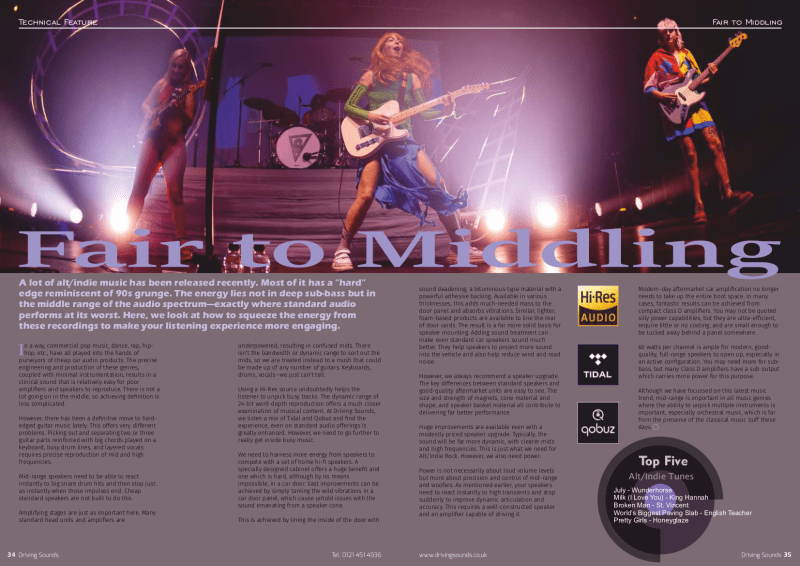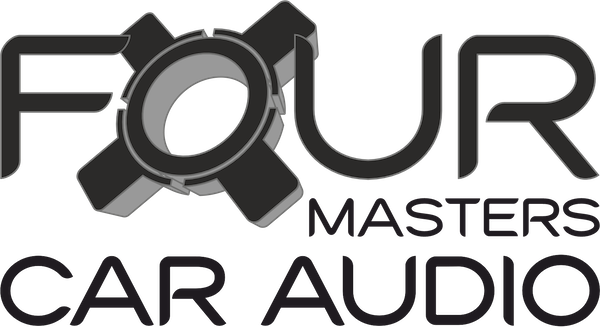
Fair to Middling
A lot of alt/indie music has been released recently. Most of it has a “hard” edge reminiscent of 90s grunge. The energy lies not in deep sub-bass but in the middle range of the audio spectrum—exactly where standard audio performs at its worst. Here, we look at how to squeeze the energy from these recordings to make your listening experience more engaging.
In a way, commercial pop music, dance, rap, hip-hop, etc., have all played into the hands of purveyors of cheap car audio products. The precise engineering and production of these genres, coupled with minimal instrumentation, results in a clinical sound that is relatively easy for poor amplifiers and speakers to reproduce. There is not a lot going on in the middle, so achieving definition is less complicated.
However, there has been a definitive move to hard-edged guitar music lately. This offers very different problems. Picking out and separating two or three guitar parts reinforced with big chords played on a keyboard, busy drum lines, and layered vocals requires precise reproduction of mid and high frequencies.
Mid-range speakers need to be able to react instantly to big snare drum hits and then stop just as instantly when those impulses end. Cheap standard speakers are not built to do this.
Amplifying stages are just as important here. Many standard head units and amplifiers are underpowered, resulting in confused mids. There isn’t the bandwidth or dynamic range to sort out the mids, so we are treated instead to a mush that could be made up of any number of guitars. Keyboards, drums, vocals—we just can’t tell.
Using a Hi-Res source undoubtedly helps the listener to unpick busy tracks. The dynamic range of 24-bit word-depth reproduction offers a much closer examination of musical content. At Driving Sounds, we listen a mix of Tidal and Qobuz and find the experience, even on standard audio offerings is greatly enhanced. However, we need to go further to really get inside busy music.
We need to harness more energy from speakers to compete with a set of home hi-fi speakers. A specially designed cabinet offers a huge benefit and one which is hard, although by no means impossible, in a car door. Vast improvements can be achieved by simply taming the wild vibrations in a car door panel, which cause untold issues with the sound emanating from a speaker cone.
This is achieved by lining the inside of the door with sound deadening, a bituminous-type material with a powerful adhesive backing. Available in various thicknesses, this adds much-needed mass to the door panel and absorbs vibrations. Similar, lighter, foam-based products are available to line the rear of door cards. The result is a far more solid basis for speaker mounting. Adding sound treatment can make even standard car speakers sound much better. They help speakers to project more sound into the vehicle and also help reduce wind and road noise.
However, we always recommend a speaker upgrade. The key differences between standard speakers and good-quality aftermarket units are easy to see. The size and strength of magnets, cone material and shape, and speaker basket material all contribute to delivering far better performance.
Huge improvements are available even with a modestly priced speaker upgrade. Typically, the sound will be far more dynamic, with clearer mids and high frequencies. This is just what we need for Alt/Indie Rock. However, we also need power.
Power is not necessarily about loud volume levels but more about precision and control of mid-range and woofers. As mentioned earlier, your speakers need to react instantly to high transients and stop suddenly to improve dynamic articulation and accuracy. This requires a well-constructed speaker and an amplifier capable of driving it.
Modern-day aftermarket car amplification no longer needs to take up the entire boot space. In many cases, fantastic results can be achieved from compact class D amplifiers. You may not be quoted silly power capabilities, but they are ultra-efficient, require little or no cooling, and are small enough to be tucked away behind a panel somewhere.
60 watts per channel is ample for modern, good-quality, full-range speakers to open up, especially in an active configuration. You may need more for sub-bass, but many Class D amplifiers have a sub output which carries more power for this purpose.
Although we have focussed on this latest music trend, mid-range is important in all music genres where the ability to unpick multiple instruments is important, especially orchestral music, which is far from the preserve of the classical music buff these days.
Top Five Alt/Indie Tunes
July – Wunderhorse
Milk Boy (I Love You) – King Hannah
Broken Man – St. Vincent
World’s Biggest Paving Slab – English Teacher
Pretty Girls - Honeyglaze
Find out what our partner, The FOUR MASTER Network, can do to bring Hi-Fi quality to your car. Simply put some brief details into the form below.
Not ready for that yet? You can use the same form to book a demonstration at your home, place of work or with your local FOUR MASTER
